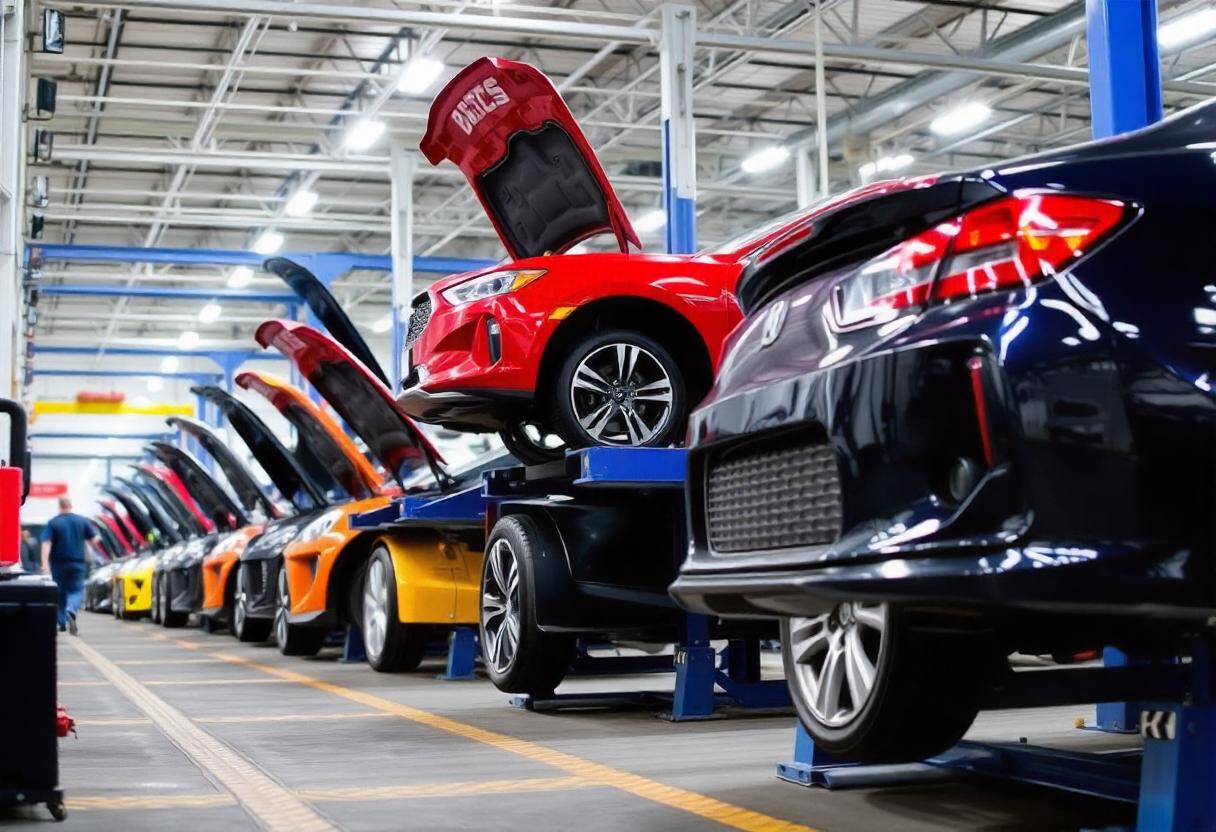
Top USA Companies in the Automotive Industry
The automotive industry in the USA is a vibrant landscape, reflecting innovation and craftsmanship. From electric vehicles to classic muscle cars, American automakers have consistently pushed the boundaries of technology and design. With numerous companies contributing to this dynamic sector, understanding the key players can illuminate trends shaping our roads.
In recent years, there has been a notable shift toward sustainability. Major manufacturers are investing heavily in electric vehicle production as they adapt to consumer demands for greener options. This transformation highlights an exciting era for both established brands and emerging startups.
As we delve into the various facets of USA companies in the automotive industry, we’ll explore manufacturing hubs that drive success across states. We’ll analyze why certain locations attract major manufacturers and take a closer look at iconic case studies like Tesla and Ford. Our journey will also introduce you to some lesser-known yet impactful names within this evolving market.
Join us as we navigate through America’s automotive giants while discovering how their contributions continue to shape not just transportation but also our economy and environment!
Major Automotive Manufacturing Hubs in the USA
The USA is home to several major automotive manufacturing hubs, each playing a crucial role in the industry’s landscape. These regions are strategic for their resources, skilled labor force, and logistical advantages.
Michigan has long been recognized as the heart of American automotive production. Detroit, often referred to as “Motor City,” hosts headquarters for General Motors, Ford, and Stellantis. The city’s rich history in car manufacturing continues to influence its economy today.
Tennessee has emerged as another significant player in the automotive sector. Smyrna is home to Nissan’s largest assembly plant outside Japan. This state also attracts various suppliers and manufacturers due to its central location and favorable business climate.
California stands out with its focus on electric vehicles and innovative tech solutions. Tesla’s Gigafactory in Fremont showcases not only traditional manufacturing but also cutting-edge advancements that are reshaping the future of automobiles.
Texas has gained momentum recently with companies like Toyota moving their North American headquarters to Plano. The state’s vast space allows for large-scale operations while benefiting from a growing workforce eager for opportunities in this booming market.
Ohio remains an essential hub thanks to its diverse supplier network and robust logistics infrastructure. Cities like Toledo have deep-rooted ties to auto part production which complements larger assembly plants throughout the region.
Analyzing Location Choices of Auto Manufacturing
Location plays a critical role in the automotive manufacturing sector. Companies often evaluate various factors before setting up their plants. Proximity to suppliers is paramount. A nearby supply chain reduces transportation costs and enhances production efficiency.
Labor availability is another key consideration. Automakers typically seek regions with skilled workers who can meet their technical needs. Areas with established training programs or vocational schools are particularly attractive for companies looking to invest.
Incentives offered by state and local governments also influence decisions significantly. Tax breaks, grants, and infrastructure improvements can sway manufacturers toward specific locations. These incentives can lower operational costs, making certain states more appealing than others.
Transportation networks matter immensely as well. Access to highways, railroads, and ports facilitates easy distribution of vehicles and parts across North America. Regions that boast robust logistics capabilities become hotspots for automotive firms seeking seamless movement of goods.
Additionally, regulatory environment shapes location choices too. States with favorable labor laws and environmental regulations may attract more automakers aiming for sustainable practices without excessive bureaucratic hurdles.
Market access cannot be overlooked when analyzing site selections for manufacturing plants. Being close to major consumer bases allows companies to respond quickly to demand changes while minimizing shipping times and costs associated with delivering vehicles directly from factories.
Case Studies: Tesla in Fremont, CA, Nissan in Smyrna, TN, Ford in Dearborn, MI
Tesla’s Fremont factory in California has become an iconic symbol of modern automotive production. Located in the heart of Silicon Valley, it benefits from proximity to a vast pool of tech talent and innovation. Tesla’s choice to build here aligns with their focus on electric vehicles and advanced technology integration. The facility is known for its high level of automation and efficiency, producing thousands of vehicles each week.
Nissan’s Smyrna plant in Tennessee stands as one of the largest auto manufacturing facilities in North America. Established in 1983, it plays a critical role in Nissan’s operations by producing popular models such as the Altima and Rogue. The strategic location allows easy access to major transportation networks, facilitating efficient distribution across the U.
S. market.
Ford’s historic presence in Dearborn, Michigan speaks volumes about its legacy within the American automotive landscape. This region has been home to Ford since its inception over a century ago. The company invests heavily in research and development at this site while also focusing on manufacturing hybrid and electric vehicle technologies.
Each automaker showcases unique strategies shaped by their respective locations. Tesla thrives on cutting-edge technology collaboration found only near Silicon Valley’s startups; Nissan capitalizes on logistical efficiencies that come from being centrally located within the U.
S.; meanwhile, Ford leverages historical ties while embracing modernization efforts right where it all began.
These case studies illustrate how geographical choices impact operational dynamics within USA companies in the automotive industry. Each manufacturer demonstrates diverse approaches tailored to regional advantages—showing no single path leads to success.
Overview of Top 24 Automotive Manufacturing Companies in the USA
The automotive industry in the USA is home to numerous manufacturing giants. These companies play a significant role in shaping global mobility trends and technological advancements.
General Motors leads the pack, producing vehicles under brands like Chevrolet and Cadillac. Their commitment to electric vehicle (EV) development is notable as they transition toward sustainable transportation solutions.
Ford Motor Company remains a household name, famous for its trucks and SUVs. The iconic Ford F-Series continues to be one of the best-selling vehicles in America while also investing heavily in EV technology.
Toyota has established itself firmly within the U.
S., known for reliability and efficiency. With production facilities across several states, Toyota produces popular models such as the Camry and RAV4.
Honda also stands out with its diverse lineup of cars, motorcycles, and power equipment. Facilities like those found in Ohio contribute significantly to their production capabilities while maintaining a strong focus on innovation.
Chrysler, now part of Stellantis, offers well-regarded brands such as Jeep and Dodge. They have successfully blended ruggedness with modern features appealing to various consumer tastes.
Other noteworthy manufacturers include Nissan, Hyundai, BMW, Volkswagen Group of America, Subaru, Mercedes-Benz USA, Tesla Motors – each bringing unique contributions that shape market dynamics throughout this essential sector.
The Big Three Automakers and Other Major Companies
The Big Three automakers have long dominated the automotive landscape in the United States. This trio includes General Motors, Ford Motor Company, and Stellantis North America (formerly Fiat Chrysler Automobiles). Together, they represent a significant share of vehicle manufacturing and sales across various segments.
General Motors is famed for its extensive lineup that includes Chevrolet, GMC, Buick, and Cadillac. With decades of innovation behind it, GM continues to invest heavily in electric vehicles (EVs) as part of their commitment to sustainability. Their Ultium battery platform is set to revolutionize how EVs are produced.
Ford has established itself as an icon in American automotive history. Known for producing reliable trucks like the Ford F-Series and popular cars such as the Mustang, Ford remains committed to electrification with models like the all-electric Ford Mustang Mach-E.
Stellantis North America combines brands like Jeep, Chrysler, Dodge, and Ram under one roof. The merger has allowed for shared resources which enhances production capabilities while focusing on creating thrilling SUVs and rugged trucks.
In addition to these giants, other major players are making waves in the industry. Toyota leads among foreign manufacturers thanks to its efficient hybrids and strong reliability reputation. Honda follows closely with innovations aimed at fuel efficiency without sacrificing performance.
Asian companies such as Hyundai and Kia have also gained considerable market share through value-driven offerings packed with technology features that compete directly against traditional American brands.
North America Automotive Market Concentration and Trends
The North American automotive market is experiencing significant shifts. An emphasis on electric vehicles (EVs) and sustainable practices is reshaping the landscape. Many traditional automakers are investing heavily in EV technology, responding to consumer demand for greener options.
Market concentration remains notable, with a few key players dominating sales and production. The Big Three—Ford, General Motors, and Stellantis—continue to command a substantial share of the market. Their combined influence impacts supply chains and labor dynamics across the industry.
Foreign manufacturers like Toyota, Honda, and Volkswagen also play crucial roles in shaping trends within the region. They bring innovative designs and advanced technologies that push American companies to stay competitive.
Additionally, there’s been an observable shift towards local manufacturing hubs. This trend aims to reduce dependency on overseas suppliers while ensuring quicker responses to changing consumer preferences. Companies are now prioritizing domestic production as part of their strategies.
Consumer preferences are evolving too; buyers increasingly seek connected features in vehicles alongside eco-friendly alternatives. As tech integration continues growing, automakers must adapt swiftly or risk losing market relevance.
Moreover, regional trade agreements impact how companies operate within North America. Tariffs or incentives can alter decisions regarding where to set up manufacturing plants or distribution centers significantly influencing cost structures across all sectors of the industry.
Discovering More Automotive Companies in the US
The automotive industry in the United States is vast and diverse, encompassing a multitude of manufacturers beyond the well-known giants. From electric vehicles to luxury brands, innovative companies are emerging to meet shifting consumer demands.
One notable sector is electric vehicle (EV) production. Companies like Rivian and Lucid Motors are gaining traction, focusing on sustainable practices and cutting-edge technology. Their commitment to innovation positions them as challengers in an evolving market landscape.
Another area experiencing growth is specialized vehicle manufacturing. Firms such as Oshkosh Corporation create purpose-built vehicles for defense, fire services, and other niche markets. These companies demonstrate that not all automotive firms fit into traditional passenger car categories.
Additionally, numerous smaller automakers contribute significantly to local economies while offering unique products. Brands like Bollinger Motors concentrate on rugged EV designs tailored for off-road enthusiasts, showcasing ingenuity alongside environmental consciousness.
In recent years, there’s been a surge in startup culture within the automotive space. New players are experimenting with autonomous driving technologies and connected vehicle solutions—pushing boundaries previously thought unattainable.
Many legacy manufacturers continue diversifying their portfolios by investing in new technologies or acquiring startups that align with future trends. This adaptability ensures they remain competitive while embracing innovative approaches essential for long-term success.
Recommended Reading and Resources
For those interested in diving deeper into the automotive industry, there are numerous resources available that can provide valuable insights. Industry reports from organizations like the Automotive News and IHS Markit offer comprehensive analyses of market trends and forecasts. These publications cover everything from sales figures to emerging technologies.
Books such as “The Car That Could” by Michael E. Hiltzik explore historical perspectives on significant companies like GM, while “Elon Musk: Tesla, SpaceX, and the Quest for a Fantastic Future” by Ashlee Vance presents an engaging look at one of today’s most influential players in automotive innovation.
Podcasts dedicated to car culture and industry news can also be enlightening. Shows like “Autoline Daily” or “Car Talk” often feature interviews with experts who discuss current events shaping the market.
Moreover, following blogs and forums focused on automotive technology—like Jalopnik or MotorTrend—can keep you updated on consumer trends and innovations within the sector.
Consider checking out educational websites such as SAE International which offers technical papers covering cutting-edge advancements in engineering related to vehicles. These resources will not only enhance your understanding but also keep you informed about how USA companies in the automotive industry continue to evolve amid changing landscapes.




